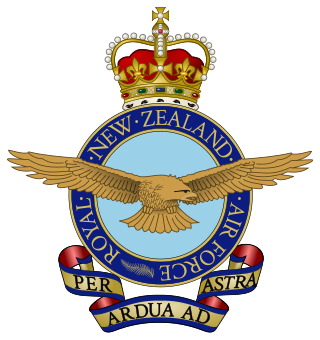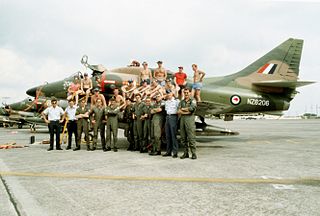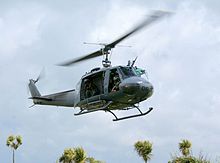
The Kaman SH-2 Seasprite is a ship-based helicopter originally developed and produced by American manufacturer Kaman Aircraft Corporation. It has been typically used as a compact and fast-moving rotorcraft for utility and anti-submarine warfare missions.

The Bell UH-1 Iroquois is a utility military helicopter designed and produced by the American aerospace company Bell Helicopter. It is the first member of the prolific Huey family, as well as the first turbine-powered helicopter in service with the United States military.

The Royal New Zealand Air Force is the aerial service branch of the New Zealand Defence Force. It was formed initially in 1923 as a branch of the New Zealand Army, being known as the New Zealand Permanent Air Force, becoming an independent air force on 1 April 1937.

No. 75 Squadron RNZAF was an air combat squadron of the Royal New Zealand Air Force. It was formed from the RAF's World War II bomber squadron, No. 75 Squadron, which had been initially equipped by the New Zealand government and was largely manned by New Zealanders. The squadron was created when, in a unique gesture, the squadron number, colours and battle honours were transferred to the RNZAF in 1946. It had flown more sorties and suffered more casualties than any other in the European theatre.

14 Squadron RNZAF is a squadron of the Royal New Zealand Air Force. In 2015 the squadron was re-raised and equipped with 11 Beechcraft T-6 Texan II. A new aerobatic display team called the Black Falcons was also formed using the new aircraft. They replaced the RNZAF display team known as the Red Checkers.
No. 75 Squadron of the Royal Air Force operated as a bomber unit in World War II, before being transferred to the Royal New Zealand Air Force in 1945. This remains the only time in RAF’s history that a squadron was gifted to another commonwealth Air Force.

RNZAF Base Ohakea is an operational base of the Royal New Zealand Air Force. Opened in 1939, it is located near Bulls, 25 km north-west of Palmerston North in the Manawatū. It is also a diversion landing point for civilian aircraft. The base's motto is Defensio per vires.

The Air Force Museum of New Zealand, formerly called The Royal New Zealand Air Force Museum, is located at Wigram, the RNZAF's first operational base, in Christchurch, in the South Island of New Zealand. It opened on 1 April 1987 as part of the celebrations for the RNZAF's 50th anniversary, and is primarily a museum of the Royal New Zealand Air Force, its predecessor, the New Zealand Permanent Air Force and New Zealand squadrons of the Royal Air Force. The Air Force Museum of New Zealand's mission is to preserve and present the history of New Zealand military aviation for commemoration, learning, inspiration and enjoyment.

No. 6 Squadron RNZAF is a maritime squadron of the Royal New Zealand Air Force. It has a history going back to World War II, when it operated flying boats, and has been disbanded and re-formed several times through changes in the country's military structure. The squadron motto, originally "Fortitudine et Diligentia", is now “Vigilance with Patience”.

The Bell 204 and 205 are the civilian versions of the UH-1 Iroquois single-engine military helicopter of the Huey family of helicopters. They are type-certificated in the transport category and are used in a wide variety of applications, including crop dusting, cargo lifting, Forestry Operations, and aerial firefighting.

The Bell Huey family of helicopters includes a wide range of civil and military aircraft produced since 1956 by Bell Helicopter. This H-1 family of aircraft includes the utility UH-1 Iroquois and the derivative AH-1 Cobra attack helicopter series and ranges from the XH-40 prototype, first flown in October 1956 to the 21st-century UH-1Y Venom and AH-1Z Viper.

The Bell H-13 Sioux is an American single-engine light helicopter built by Bell Helicopter and manufactured by Westland Aircraft under license for the British military as the Sioux AH.1 and HT.2.

The Kaman SH-2G Super Seasprite is an American ship-based helicopter with anti-submarine, anti-surface threat capability, including over-the-horizon targeting. This aircraft extends and increases shipboard sensor and weapon capabilities against several types of enemy threats, including submarines of all types, surface ships, and patrol craft that may be armed with anti-ship missiles. It was originally developed for the United States Navy in the 1980s as a reengined version of the older Kaman SH-2 Seasprite.

The Royal New Zealand Air Force (RNZAF) is organised into a small number of flying squadrons and ground-based units. Most of the RNZAF's operational and training units are stationed at RNZAF Base Auckland and RNZAF Base Ohakea in the North Island. Several training and maintenance units are located at RNZAF Base Woodbourne in the South Island.
No. 488 Wing was the wing of the Royal New Zealand Air Force (RNZAF) with responsibility for commanding all units based at RNZAF Base Ohakea. It was established in December 2010 and disbanded in March 2015.

The history of aviation in New Zealand began in the late 19th century when balloon flights began. In the first decade of the 20th century, several New Zealanders began developing heavier-than-air craft. The first confirmed powered flight in New Zealand being made by Richard Pearse in 1902 though is considered uncontrolled.

In May 2001 the Fifth Labour Government of New Zealand decided to disband the Royal New Zealand Air Force's air combat force by withdrawing its Douglas A-4K Skyhawk fighter aircraft and Aermacchi MB-339 trainers without replacement. This followed a debate over whether 28 General Dynamics F-16 A/B Fighting Falcon fighter aircraft should be leased from the United States to replace the Skyhawks. The RNZAF's air combat units were disbanded in October 2001, and many of the aircraft were eventually sold.


















